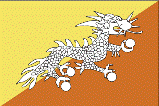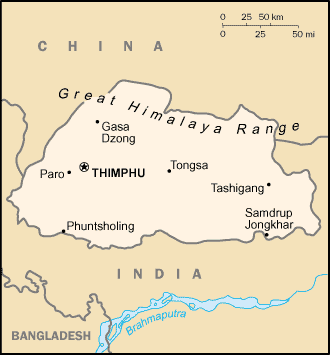|
Bhutan
|

|
Capital: Thimphu
Population: 763,092
Brief History of Bhutan:
Bhutan's history is very influenced by religion. Recorded history in Bhutan starts in the 9th century when monks from Tibet immigrated to get away from turmoil in their own land. For much of history, a major source of power in Bhutan was held by various religious schools. The Drukpa Kagyupa school of Buddhism was formed in the 12th century. It is still the main form of Buddhism in Bhutan.
Bhutan remained ruled by a number of religious schools until 1616 when Ngawana Namgyal took leadership. He became the ruler, called the shabdrung. During this time the country was at its most united and was ruled under one law. After Ngawana died, it was 200 years until the next great leader would take power.
In 1885 Ugyen Wangchuck became the next powerful ruler. He became the Dragon Kin in 1907.
After his death, infighting and civil war eroded the power of the shabdrung for the next 200 years when in 1885, Ugyen Wangchuck was able to consolidate power and cultivated closer ties with the British in India. Both Ugyen and later his son, Jigme established diplomatic ties with India. Bhutan became recognized as an independent country in 1947 and signed a Treaty of Peace and Friendship with India in 1949.
The Geography of Bhutan
Total Size: 47,000 square km
Size Comparison: about half the size of Indiana
Geographical Coordinates: 27 30 N, 90 30 E
World Region or Continent: Asia
General Terrain: mostly mountainous with some fertile valleys and savanna
Geographical Low Point: Drangme Chhu 97 m
Geographical High Point: Kula Kangri 7,553 m
Climate: varies; tropical in southern plains; cool winters and hot summers in central valleys; severe winters and cool summers in Himalayas
Major cities: THIMPHU (capital) 89,000 (2009)
The People of Bhutan
Type of Government: monarchy; special treaty relationship with India
Languages Spoken: Dzongkha (official), Bhotes speak various Tibetan dialects, Nepalese speak various Nepalese dialects
Independence: 8 August 1949 (from India)
National Holiday: National Day (Ugyen WANGCHUCK became first hereditary king), 17 December (1907)
Nationality: Bhutanese (singular and plural)
Religions: Lamaistic Buddhist 75%, Indian- and Nepalese-influenced Hinduism 25%
National Symbol: thunder dragon known as Druk
National Anthem or Song: Druk tsendhen (The Thunder Dragon Kingdom)
Economy of Bhutan
Major Industries: cement, wood products, processed fruits, alcoholic beverages, calcium carbide
Agricultural Products: rice, corn, root crops, citrus, foodgrains; dairy products, eggs
Natural Resources: timber, hydropower, gypsum, calcium carbonate
Major Exports: electricity (to India), cardamom, gypsum, timber, handicrafts, cement, fruit, precious stones, spices
Major Imports: fuel and lubricants, grain, machinery and parts, vehicles, fabrics, rice
Currency: ngultrum (BTN); Indian rupee (INR)
National GDP: $4,309,000,000
** Source for population (2012 est.) and GDP (2011 est.) is CIA World Factbook.
Back to Geography Home Page
